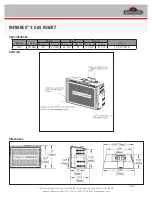
BODEGA BAY WOOD INSERT
Page 16
August 20, 2008
R
435-1320B
WOOD SELECTION AND STORAGE
Burn only dry seasoned wood. Dry, well-seasoned wood will not only minimize the chance of creosote formation but will give you the
most efficient heat output. Even dry wood contains at least 15% moisture by weight and should be burned hot enough to keep the
chimney hot enough to maintain particulate (smoke) burning. Burning unseasoned wood of any variety defeats the inserts’ efficiency.
Dead wood lying on the forest floor should be considered wet, and requires full seasoning time. Standing wood can be considered to be
about 2/3 seasoned. Wood is dry enough to burn if the ends of the logs have cracks radiating in all directions from the center. If your
wood sizzles in the fire, even though the surface is dry, it may not be fully cured.
Drying time can be reduced by splitting wood prior to storage. Since the majority of drying occurs through the cut ends rather than the
sides, stack the wood so both ends of each piece are exposed to air. Store wood under cover, such as in a shed, or covered with a tarp,
plastic, tarpaper, sheets of scrap plywood, etc.
OVERFIRING
Do not overfire. Overfiring can result in crazing, an effect causing a white, non-removable film to be deposited on the inside of the glass.
Using flammable liquids, too much wood or burning trash in the insert may result in overfiring. If the chimney connector or insert glows
red, or worse, white, the insert is overfired. This condition may ignite creosote in the chimney, possibly causing a house fire. If any part
of the insert starts to glow, you are in an overfire situation. If you overfire, immediately close the insert air controls and door, if open, to
reduce the air supply to the fire.
Overfiring your insert voids your warranty.
NOTE: The special high temperature finish paint applied to the insert will cure as your insert heats. You will notice an odor
and perhaps see some vapor rise from the insert surface, this is normal. We recommend that you open a window until the odor
dissipates and the paint is cured.
OPERATION
Before lighting your first fire in the insert, make certain that the baffle is correctly positioned. It should be resting against the rear support.
Also refer to care and cleaning of plated surfaces on
page 19
before lighting your first fire.
CAUTION: Never use gasoline, gasoline-type lantern fuel, kerosene, charcoal lighter fluid, or similar liquids to start or “freshen
up” a fire in this heater. Keep all such liquids well away from the heater while it is in use.
There are many ways to build a fire. The basic principle is to light easily-ignitable tinder or paper, which ignites the fast-burning kindling,
which in turn ignites the slow-burning firewood. Here is one method that works well:
1. Place several wads of crushed paper on the firebox floor.
Heating flue with slightly crumpled newspaper before adding
kindling keeps smoke to a minimum.
2. Place several wads of crushed paper on the firebox floor.
3.
Open Start-Up Air Control (bottom rod) and Primary Air Control (top rod) fully.
See Figure 18A on page 18
4.
Ensure that no matches or other combustibles are in the immediate area of the insert, that the room is adequately ventilated,
and the flue is unobstructed.
5. Light the paper in the insert. NEVER light or rekindle insert with kerosene, gasoline, or charcoal lighter fluid; the results
can be fatal.
6. Once the kindling is burning quickly, add several full-length logs 3 inches (76mm) or 4 inches (102mm) in diameter. Be careful not
to smother the fire. Stack the pieces of wood carefully. They should be near enough to keep each other hot, but far enough away
from each other to allow adequate air flow between them.
7. When ready to reload the insert, add more logs. Large logs burn slowly, holding a fire longer. Small logs burn fast and
hot, giving quick heat.
8. Adjust the Start-Up Air Control and Primary Air Control, maintaining flames above the fuel. The more you close down the Primary
Control, the lower and slower the fire will burn. The more you open the Primary Control the more heat will be produced. The
Start-Up Air Control (bottom rod) is only used for the first 5 to 15 minutes.
As long as there are hot coals, repeating steps 7 and 8 will maintain a continuous fire.
BUILDING A FIRE
NOTE: Remove all labels from glass front prior to lighting the first fire.









































